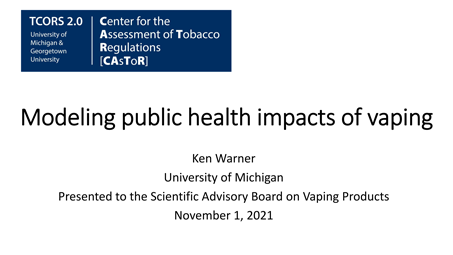Understanding impact of potential FDA regulatory actions
60
View Impact Analysis publications
Understanding the short and long term health effects of tobacco products
54
View Health Effects publications
Understanding the knowledge, attitudes and behaviors related to tobacco product use and changes in tobacco product characteristics
114
View Behavior publications
 Modeling public health impacts of vaping AUTHORS: Ken Warner (Avedis Donabedian Distinguished University Professor Emeritus of Public Health; Professor Emeritus of Health Management & Policy; Dean Emeritus of Public Health) DESCRIPTION: Presented to the Scientific Advisory Board on Vaping Products
November 1, 2021
Modeling public health impacts of vaping AUTHORS: Ken Warner (Avedis Donabedian Distinguished University Professor Emeritus of Public Health; Professor Emeritus of Health Management & Policy; Dean Emeritus of Public Health) DESCRIPTION: Presented to the Scientific Advisory Board on Vaping Products
November 1, 2021